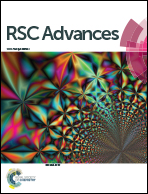Cooperative halogen bonds in V-shaped H3N·X1X2·X3Y (X1, X2, X3 = Cl and Br; Y = F, Cl and Br) complexes†
Abstract
A series of V-shaped molecular complexes formed by NH3, X1X2 and X3Y (X1, X2, X3 = Cl, Br; Y = F, Cl, Br) molecules via two halogen bonds (i.e., N⋯X1 and X2⋯X3 interactions) have been investigated at the MP2/aug-cc-pVTZ level of theory to obtain their optimized geometries, stretching modes and interaction energies. Molecular electrostatic potential was used to illustrate how X1 and X2 act as the halogen bond donor and acceptor in N⋯X1 and X2⋯X3 interactions, respectively. The evaluation of the binding distances, interaction energies and the electron density at the bond critical points of the halogen bonds reveals the existence of cooperativity between the two halogen bonds. Subsequently, the concepts of pair interaction and pairwise non-additive contributions to the total interaction energy, and the cooperativity factor were further employed to assess the cooperativity. The formation mechanisms of these complexes were analyzed based on the contour maps of the Laplacian (∇2ρ) of electron density. Energy decomposition analysis suggests that electrostatic force is the main net contribution to the stability of these complexes. The work would provide valuable insights into the design of related halogen-bonded complexes.


 Please wait while we load your content...
Please wait while we load your content...